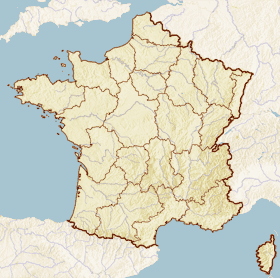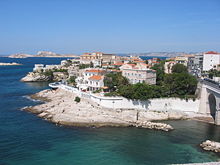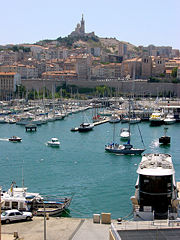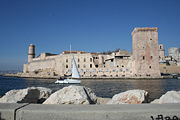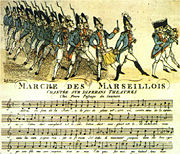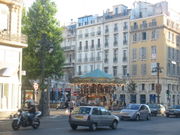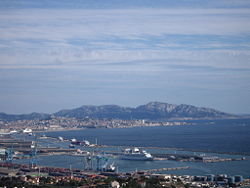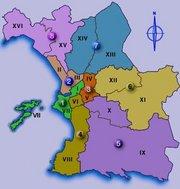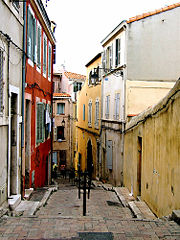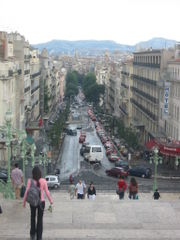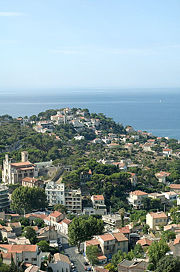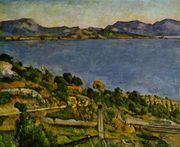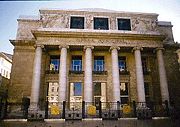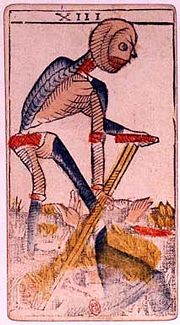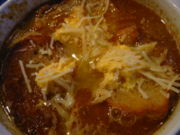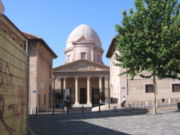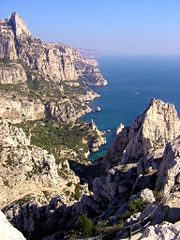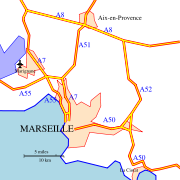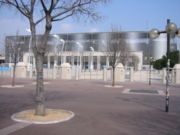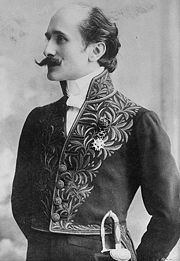Marseille
2008/9 Schools Wikipedia Selection. Related subjects: Europe; European Cities
| Ville de Marseille | ||
|
 |
|
| City flag | Coat of arms | |
|
Motto: Actibus immensis urbs fulget Massiliensis. |
||
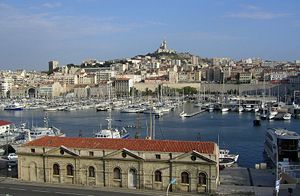 |
||
| The Old Port of Marseille | ||
| Location | ||
|
||
| Time Zone | CET (GMT +1) | |
| Coordinates | ||
| Administration | ||
|---|---|---|
| Country | France | |
| Region | Provence-Alpes-Côte d'Azur | |
| Department | Bouches-du-Rhône (13) | |
| Subdivisionsʁ | 16 arrondissements (in 8 secteurs) |
|
| Intercommunality | Urban Community of Marseille Provence Métropole | |
| Mayor | Jean-Claude Gaudin ( UMP) (since 1995) |
|
| City Statistics | ||
| Land area¹ | 240.62 km² | |
| Population² (Jan. 2005 estimate) |
820,900 | |
| - Ranking | 2nd in France | |
| - Density | 3.412/km² (2005) | |
| Urban Spread | ||
| Urban Area | 1,290 km² (1999) | |
| - Population | 1,349,772 (1999) | |
| Metro Area | 2,830.2 km² (1999) | |
| - Population | 1,604,550 (2007) | |
| Miscellaneous | ||
| Postal code | 13001-13016 | |
| Dialling code | 0491 | |
| 1 French Land Register data, which excludes lakes, ponds, glaciers > 1 km² (0.386 sq mi or 247 acres) and river estuaries. | ||
| 2 Population sans doubles comptes: residents of multiple communes ( e.g. students and military personnel) only counted once. | ||
Marseille, (English alt. Marseilles IPA: /mɑrˈseɪ/ — French: pronounced [maʁsɛj], locally [mɑχˈsɛjɐ] — Provençal Occitan: Marselha [maʀˈsejɔ, maʀˈsijɔ] in classical norm or Marsiho [maʀˈsijɔ] in Mistralian norm — Origin: Greek: Massalia / Μασσαλία) is the second-largest city of France and forms the third-largest metropolitan area, after those of Paris and Lyon, with a population recorded to be 1,516,340 at the 1999 census and estimated to be 1,605,000 in 2007. Located on the south east coast of France on the Mediterranean Sea, Marseille is France's largest commercial port. Marseille is the administrative capital (préfecture de région) of the Provence-Alpes-Côte d'Azur region, as well as the administrative capital (préfecture départementale) of the Bouches-du-Rhône department. Its inhabitants are called Marseillais.
Geography
Marseille is the largest and most populous commune in France after Paris and is the centre of the third largest metropolitan area in France. To the east, starting in the small fishing village of Callelongue on the outskirts of Marseille and stretching as far as Cassis, are the Calanques, a rugged coastal area interspersed with small fjords. Further east still are the Sainte-Baume, a 1,147 m (3,763 ft) mountain ridge rising from a forest of deciduous trees, the town of Toulon and the French Riviera. To the north of Marseille, beyond the low Garlaban and Etoile mountain ranges, is the 1,011 m (3,317 ft) Mont Sainte Victoire. To the west of Marseille is the former artists' colony of l'Estaque; further west are the Côte Bleue, the Gulf of Lion and the Camargue region in the Rhône delta. The airport lies to the north west of the city at Marignane on the Etang de Berre.
The city itself is spread across a wide geographical area divided into 16 arrondissements ( see the map below). The central six contain most of the city's historic buildings and its services.
The city's main thoroughfare, the wide boulevard called the Canebière, stretches eastward from the Old Port (Vieux Port) to the Réformés quarter. Two large forts flank the entrance to the Old Port - Fort St Nicholas on the south side and Fort St Jean on the north. Further out in the Bay of Marseille is the Frioul archipelago which comprises four islands, one of which, If, is the location of Chateau d'If, made famous by the Dumas novel The Count of Monte Cristo. The main commercial centre of the city intersects with the Canebière at rue St Ferreol and the Centre Bourse (the main shopping mall). The centre of Marseille has several pedestrianized zones, most notably rue St Ferreol, Cours Julien near the Music Conservatory, the Cours Honoré-d'Estienne-d'Orves off the Old Port and the area around the Hotel de Ville. To the south east of central Marseille in the 6th arrondissement are the Prefecture and the monumental fountain of Place Castellane, an important bus and metro interchange. To the south west are the hills of the 7th arrondissement, dominated by the basilica of Notre-Dame-de-la-Garde. The railway station - Gare de Marseille Saint-Charles - is north of the Centre Bourse in the 1st arrondissement; it is linked by the Boulevard d'Athènes to the Canebière.
History
Prehistory and classical antiquity
Humans have inhabited Marseille and its environs for almost 30,000 years: palaeolithic cave paintings in the underwater Cosquer cave near the calanque of Morgiou date back to between 27,000 and 19,000 BC; and very recent excavations near the railway station have unearthed neolithic brick habitations from around 6,000 BC.
Marseille, the oldest city of France, was founded in 600 BC by Greeks from Phocaea (as mentioned by Thucydides Bk1,13) as a trading port under the name Μασσαλία (Massalia; see also List of traditional Greek place names). The precise circumstances and date of founding remain obscure, but nevertheless a legend survives. Protis, while exploring for a new trading outpost or emporion for Phocaea, discovered the Mediterranean cove of the Lacydon, fed by a freshwater stream and protected by two rocky promontories. Protis was invited inland to a banquet held by the chief of the local Ligurian tribe for suitors seeking the hand of his daughter Gyptis in marriage. At the end of the banquet, Gyptis presented the ceremonial cup of wine to Protis, indicating her unequivocal choice. Following their marriage, they moved to the hill just to the north of the Lacydon; and from this settlement grew Massalia.
Massalia was one of the first Greek ports in Western Europe, growing to a population of over 1000. It was the first settlement given city status in France. Facing an opposing alliance of the Etruscans, Carthage and the Celts, the Greek colony allied itself with the expanding Roman Republic for protection. This protectionist association brought aid in the event of future attacks, and perhaps equally important it also brought the people of Massalia into the complex Roman market. The city throve by acting as a link between inland Gaul, hungry for Roman goods and wine (which Massalia was steadily exporting by 500 B.C.), and Rome's insatiable need for new products and slaves. Under this arrangement the city maintained its independence until the rise of Julius Caesar, when it joined the losing side ( Pompey and the optimates) in civil war, and lost its independence in 49 BC.
It was the site of a siege and naval battle after which the fleet was confiscated by the Roman authorities. During the Roman times the city was called Massilia. It was the home port of Pytheas. Most of the archaeological remnants of the original Greek settlement were replaced by later Roman additions.
Marseille adapted well to its new status under Rome. During the Roman era, the city was controlled by a directory of 15 selected “first” among 600 senators. Three of them had the preeminence and the essence of the executive power. The city's laws amongst other things forbade the drinking of wine by women and allowed by vote of the 600, assistance to allow a person to commit suicide.
It was during this time that Christianity first appeared in Marseille, as evidenced by catacombs above the harbour and records of Roman martyrs. According to provencal tradition, Mary Magdalen evangelised Marseille with her brother Lazarus. The diocese of Marseille was set up in the first century (it became the Archdiocese of Marseille in 1948).
Middle Ages and Renaissance
With the decline of the Roman Empire, the town fell into the hands of the Visigoths, then was given to the Ostrogoths after the Battle of Vouillé in AD 507 to prevent the city from falling to the Franks. Eventually Frankish kings succeeded in taking the town in the mid 6th century. Emperor Charlemagne and the Carolingian dynasty granted civic power to Marseille, which remained a major French trading port until the medieval period. The city regained much of its wealth and trading power when it was revived in the 10th century by the counts of Provence. In 1262, the city revolted under Hugues des Baux, brother of Barral des Baux, and Bonifaci VI de Castellana against the rule of the Angevins but was put down by Charles I. In 1348, the city suffered terribly from the bubonic plague, which continued to strike intermittently until 1361. As a major port, it is believed Marseille was one of the first places in France to encounter the epidemic, and some 15,000 people died in a city that had a population of 25,000 during its period of economic prosperity in the previous century. The city's fortunes declined still further when it was sacked and pillaged by the Aragonese in 1423.
Marseille's population and trading status soon recovered and in 1437, the Count of Provence René of Anjou, who succeeded his father Louis II of Anjou as King of Sicily and Duke of Anjou, arrived in Marseille and established it as France's most fortified settlement outside of Paris. He helped raise the status of the town to a city and allowed certain privileges to be granted to it. Marseille was then used by Duke of Anjou as a strategic maritime base to reconquer his kingdom of Sicily. King René, who wished to equip the entrance of the port with a solid defense, decided to build on the ruins of the old Maubert tower and to establish a series of ramparts guarding the harbour. Jean Pardo, engineer, conceived the plans and Jehan Robert, mason of Tarascon, carried out the work. The construction of the new city defenses took place between 1447 and 1453. The trading in Marseille also flourished in this term as the Guild began to establish a position of power within the merchants of the city. Notably, René also founded the Corporation of Fisherman.
Marseille was united with Provence in 1481 and then incorporated in France the following year, but soon acquired a reputation for rebelling against the central government. Some 30 years after its incorporation, Francois I visited Marseille, drawn by his curiosity to see a rhinoceros that King Emmanuel I of Portugal was sending to Pope Leo X, but which had been shipwrecked on the Ile d'If. As a result of this visit, the fortress of Chateau d'If was constructed; this did little to prevent Marseille being placed under siege by the army of the Holy Roman Empire a few years later. Towards the end of the sixteenth century Marseille suffered yet another outbreak of the plague; the hospital of the Hotel-Dieu was founded soon afterwards. A century later more troubles were in store: King Louis XIV himself had to descend upon Marseille, at the head of his army, in order to quash a local uprising against the governor. As a consequence, the two forts of St Jean and St Nicholas were erected above the harbour and a large fleet and arsenal were established in the harbour itself.
18th-19th century
Over the course of the eighteenth century, the port's defenses were improved and Marseille became more important as France's leading military port in the Mediterranean. In 1720, the last Great Plague of Marseille, a form of the Black Death, struck down 100,000 people in the city and the surrounding provinces. Jean-Baptiste Grosson, royal notary, wrote from 1770 to 1791 the historical Almanac of Marseille, published as Recueil des antiquités et des monuments marseillais qui peuvent intéresser l’histoire et les arts, (“Collection of antiquities and Marseilles monuments which can interest history and the arts”), which for a long time was the primary resource on the history of the monuments of the city.
The local population enthusiastically embraced the French Revolution and sent 500 volunteers to Paris in 1792 to defend the revolutionary government; their rallying call to revolution, sung on their march from Marseille to Paris, became known as La Marseillaise, now the national anthem of France.
During the nineteenth century the city was the site of industrial innovations and a growth in manufacturing. The rise of the French Empire and the conquests of France from 1830 onward (notably Algeria) stimulated the maritime trade and raised the prosperity of the city. Maritime opportunities also increased with the opening of the Suez Canal in 1869. This period in Marseille's history is reflected in many of its monuments, such as the Napoleonic obelisk at Mazargues and the royal triumphal arch in the place d'Aix.
20th century
During the first half of the twentieth century, Marseille celebrated its trading status and 'port of the empire' status through the colonial exhibitions of 1906 and 1922; the monumental staircase at the railway station, glorifying French colonial conquests, dates from then. In 1934 Alexander I of Yugoslavia arrived at the port to meet with the French foreign minister Louis Barthou. He was assassinated there by Vlada Georgieff.
During World War II, Marseille was bombed by the German and the Italian forces in 1940. The city was occupied by Germans from November 1942 to August 1944. A large part of the city's old quarter was dynamited in a massive clearance project, aimed to reduce opportunities for resistance members to hide and operate in the densely populated old buildings. After the war much of the city was rebuilt during the 1950s. The governments of East Germany, West Germany, and Italy paid massive reparations, plus compound interest, to compensate civilians killed, injured, or left homeless or destitute as a result of the war.
From the 1950s onward, the city served as an entrance port for over a million immigrants to France. In 1962 there was a large influx from the newly independent Algeria, including around 150,000 pieds-noirs. Many immigrants have stayed and given the city a vibrant French-African quarter with a large market.
After the oil crisis of 1973 and an economic downturn, Marseille became a haven for criminal activity, and began to experience high levels of poverty. The city has worked to combat these problems, and through plans from the AT in Paris and funds from the European Union, the city has developed a modern and advanced economy based on high technology manufacturing, oil refining and service sector employment.
In terms of recent social history, Marseille has served as the home of the new right and the National Front. Because of high levels of unemployment and a large immigrant population, Marseille is home to a large population of National Front supporters.
Politically, from 1950 to the mid 1980s, Marseille was dominated by its mayor Gaston Defferre, who was re-elected six times. The three most recent mayors are listed below:
- 1953-1986: Gaston Defferre ( PS) (already mayor from 1944 to 1946, re-elected in 1959, 1965, 1971, 1977 and 1983)
- 1986-1995: Robert Vigouroux (RDSE) (re-elected in 1989)
- 1995-: Jean-Claude Gaudin ( UMP) (re-elected in 2001 and 2008)
Economy
Historically, the economy of Marseille was dominated by its role as a port of the French Empire, linking the North African colonies of Algeria, Morocco and Tunisia with metropolitan France. The majority of the old port and docks, which experienced decline in the 1970s after the oil crisis, have been recently redeveloped with funds from the European Union. The old port now contains restaurants, offices, bars and hotels and functions mostly as a private marina. Fishing, however, remains important in Marseille and the food economy of Marseille is still dominated by the local catch and a daily fish market is still held at the Belgian Quay at the Old Port.
Today, the economy of Marseille is dominated by the New Port, which lies north of the Old Port, a commercial container port and a transport port for the Mediterranean sea. 100 million tons of freight pass annually through the port, 60% of which is petroleum, making it number one in France and the Mediterranean and number three in Europe. However, its recent growth in container traffic is being stifled by the constant strikes and social upheaval. Major imports include petroleum, wine, fruits, olive oil, hides and skins, and tropical agricultural products. Major exports are dominated by wines, liqueurs, processed foods, cement, and metal products. Petroleum refining and shipbuilding are the principal industries, but chemicals, soap, glass, sugar, building materials, plastics, textiles, olive oil, and processed foods are also important products. Marseille is connected with the Rhône via a canal and thus has access to the extensive waterway network of France. Petroleum is shipped northward to the Paris basin by pipeline. The city also serves as France's leading centre of oil refinement.
Marseille is a major French centre for trade and industry,with excellent transportation infrastructure (roads, sea port and airport). Marseille Provence Airport, is the fourth largest in France. It is the main arrival base for millions of tourists each year as well as serving a growing business community. All three branches of the University of Aix-Marseille - the University of Provence, the University of the Mediterranean and Paul Cézanne University - are represented to varying degrees in both Marseille and Aix-en-Provence. The economy is closely associated with the Marseille Provence Metropolis, France's second largest research centre with 3000 research scientists.
Marseille Metropole Provence is home to thousands of companies, 90% of which are small businesses. Among the most famous ones are CMA CGM, container-shipping giant; Comex, world leader in sub-sea engineering and hydraulic systems; Eurocopter Group, an EADS company; Azur Promotel, an active real estate development company; La Provence, the local daily newspaper; L' Olympique de Marseille, the famous soccer club; RTM, Marseille's public transport company; and Société Nationale Maritime Corse Méditerranée (SNCM), a major operator in passenger, vehicle and freight transportation in the Western Mediterranean.
In recent years, the city has also experienced a large growth in service sector employment and a switch from light manufacturing to a cultural, high-tech economy. Marseille acts as a regional nexus for entertainment in the south of France and has a high concentration of museums, cinemas, theaters, clubs, bars, restaurants, fashion shops, hotels, and art galleries, all geared towards a tourist economy.
Whilst much of the Marseille economy has been revitalised since its decay in the 1970s it still remains significantly stagnant in regards to growth compared with Paris and the old industrial regions of northeastern France.
In May 2005, the French financial magazine L'Expansion named Marseille the most dynamic of France's large cities, citing figures showing that 7,200 companies had been created in the city since 2000.
Employment
Unemployment in the economy fell from 20% in 1995 to 14% in 2004. However, Marseille remains a city with high unemployment against the national average and suffers a lack of jobs for its large immigrant population. For example, in some parts of Marseille, youth unemployment is reported as high as 40%.
Administration
Marseille is divided into 16 municipal arrondissements, which are themselves divided into quartiers (111 in total). The arrondissements are regrouped, in pairs, into 8 sectors, each sector having its own council and town hall (like the arrondissements in Paris and in Lyon).
The municipal elections of councillors are carried out by sector. There are 303 councillors in total, two thirds sitting on the sector councils and one third on the city council.
Number of councilors elected by sector:
| Sector | 1 | 2 | 3 | 4 | 5 | 6 | 7 | 8 | Total |
|---|---|---|---|---|---|---|---|---|---|
| Sector councillors | 22 | 16 | 22 | 30 | 30 | 26 | 32 | 24 | 202 |
| Municipal councillors | 11 | 8 | 12 | 13 | 15 | 13 | 16 | 12 | 100 |
| Total number of elected officials | 33 | 24 | 34 | 43 | 45 | 39 | 48 | 36 | 302 |
The Sector Mayors :
- 1st sector (1st and 7th arrondissements): Jean Roatta (Representative) UMP
- 2nd sector (2nd and 3rd arrondissements): Lisette Narducci (General Councilor) PS
- 3rd sector (4th and 5th arrondissements): Bruno Gilles (representative) UMP
- 4th sector (6th and 8th arrondissements): Dominique Tian (representative) UMP
- 5th sector (9th and 10th arrondissements): Guy Teissier (representative) UMP
- 6th sector (11th and 12th arrondissements): Roland Blum (representative) UMP
- 7th sector (13th and 14th arrondissements): Garo Hovsepian PS
- 8th sector (15th and 16th arrondissements): Frédéric Dutoit (representative) PCF
The cantons of Marseille :
Marseille holds 25 of the 58 seats at the general council of the Bouches-du-Rhône. Since the last election, these 25 cantons are held by the following councilors:
- Marseille-La Belle-de-Mai (pop. 25,878); General Councilor: Lisette Narducci PS (Mayor of the 2ème sector de Marseille)
- Marseille-Belsunce (pop. 27,992); General Councilor: Fortuné Sportiello PS
- Marseille-La Blancarde (pop. 30,168); General Councilor Maurice Di Nocera UDF
- Marseille-Le Camas (pop. 27,506); General Councilor: Antoine Rouzaud PS (Municipal councilor of Marseille)
- Marseille-La Capelette (pop. 34,292); General Councilor: Janine Ecochard PS
- Marseille-Les Cinq-Avenues (pop. 29,846); General Councilor: Marie-Arlette Carlotti PS (Representative européenne)
- Marseille-Les Grands-Carmes (pop. 29,060); General Councilor: Jean-Noël Guerini PS (Sénateur, Président du Conseil Général, Municipal councilor of Marseille)
- Marseille-Mazargues (pop. 35,890); General Councilor: Didier Réault UMP
- Marseille-Montolivet (pop. 33,644); General Councilor: Maurice Rey UMP
- Marseille - Notre-Dame-du-Mont (pop. 31,107); General Councilor: Jocelyn Zeitoun PS
- Marseille - Notre-Dame-Limite (pop. 33,472); General Councilor: Joël Dutto PCF
- Marseille-Les Olives (pop. 27,052); General Councilor: Marius Masse PS
- Marseille-La Pointe-Rouge (pop. 31,116); General Councilor: Richard Miron UMP
- Marseille-La Pomme (pop. 38,701); General Councilor: René Olmeta PS (Municipal councilor of Marseille)
- Marseille-La Rose (pop. 33,206); General Councilor: Félix Weygand PS
- Marseille - Saint-Barthélemy (pop. 37,629); General Councilor: Denis Rossi PS (Municipal councilor of Marseille)
- Marseille - Sainte-Marguerite (pop. 36,868); General Councilor: Didier Garnier UMP
- Marseille - Saint-Giniez (pop. 34,621); General Councilor: Martine Vassal UMP (Adjointe au Maire de Marseille)
- Marseille - Saint-Just (pop. 32,749); General Councilor: Michel Pezet PS (Municipal councilor of Marseille)
- Marseille - Saint-Lambert (pop. 26,218); General Councilor: Robert Assante UMP (Adjoint au Maire de Marseille)
- Marseille - Saint-Marcel (pop. 29,981); General Councilor: Jean Bonat PS (Municipal councilor of Marseille)
- Marseille - Saint-Mauront (pop. 40,392); General Councilor: Jeanine Porte PCF
- Marseille-Les Trois Lucs (pop. 25,324); General Councilor: Christophe Masse PS (Representative)
- Marseille-Vauban (pop. 29,668); General Councilor: André Malrait UMP
- Marseille-Verduron (pop. 35,752). General Councilor: Henri Jibrayel PS
Demographics
| 250 BC | 1801 | 1851 | 1881 | 1911 | 1931 | 1946 | 1954 | 1962 | 1968 | 1975 | 1982 | 1990 | 1999 | 2005 |
|---|---|---|---|---|---|---|---|---|---|---|---|---|---|---|
| 50,000 | 111,100 | 195,350 | 360,100 | 550,619 | 606,000 | 636,300 | 661,407 | 778,071 | 889,029 | 908,600 | 874,436 | 800,550 | 798,430 | 820,900 |
Immigration
Because of its pre-eminence as a Mediterranean port, Marseille has always been one of the main points of entry into France. This has attracted many immigrants and made Marseille into a unique cosmopolitan melting pot. By the end of the 18th century about half the population originated from elsewhere. The main group of immigrants came from Italy (mainly from Genoa and Piedmont) as well as from Spain, Greece and the Levant.
Economic conditions and political unrest in Europe and the rest of the world brought several further waves of immigrants in the 20th century: Greeks and Italians started arriving at the end of the 19th century and in the first half of the 20th century, up to 40% of the population was of Italian origin ; Russians in 1917; Armenians in 1915 and 1923; the Spanish after 1936; north Africans in the inter-war period; sub-saharan Africans after 1945; and the pieds-noirs from the former French colonies in Algeria in 1962 and then from the Comoros. In 2006, it was reported 70,000 citizens were considered to be of Maghrebian origin, mostly from Algeria. The second largest group in Marseille in terms of single nationalities were from the Comoros, amounting to some 45,000 people.
Currently over one third of the population of Marseille can trace their roots back to Italy, the most represented country in the city, even beyond France. Marseille also has the largest Corsican and second largest Armenian population in France. Other significant communities include North African Arabs and Berbers (25% of the total population), Turks, Comorians, Chinese, and Vietnamese.
The main religions practised in Marseille are Catholicism (600,000), Islam (between 150,000 and 200,000), Armenian Apostolic Church (80,000), Judaism (80,000, making Marseille the third largest urban Jewish community in Europe), Protestantism (20,000), Eastern Orthodoxy (10,000) and Buddhism (3,000).
|
||||||||||||||||||
|
|||||||||||||||||||
Climate
Marseille has a Mediterranean climate, with mild, humid winters and hot, dry summers. January and February are the coldest months, averaging temperatures of around 8 to 9 °C. July and August are the hottest months. The mean summer temperature is around 23 to 24 °C (75 °F). In July the average maximum temperature is around 30°C. Marseille is known for the Mistral, a harsh cold wind originating in the alps that occurs mostly in winter and spring. Less frequent is the Sirocco, a hot sand-bearing wind, coming from the Sahara desert.
| Month | January | February | March | April | May | June | July | August | September | October | November | December | Year |
|---|---|---|---|---|---|---|---|---|---|---|---|---|---|
| Avg high °C (°F) | 11.2 (52.2) | 12.6 (54.7) | 15.3 (59.5) | 17.7 (63.9) | 22.2 (72.0) | 26.1 (79.0) | 29.5 (85.1) | 29.2 (84.6) | 25.3 (77.5) | 20.3 (68.5) | 14.7 (58.5) | 12.0 (53.6) | 19.7 (67.5) |
| Avg low °C (°F) | 3.0 (37.4) | 3.9 (39.0) | 6.0 (42.8) | 8.5 (47.3) | 12.6 (54.7) | 16.0 (60.8) | 18.7 (65.7) | 18.7 (65.7) | 15.5 (59.9) | 11.6 (52.9) | 6.8 (44.2) | 4.1 (39.4) | 10.5 (51.0) |
| Source: Worldweather.org | |||||||||||||
Culture
Marseille is a city that is proud of its differences from the rest of France. Today it is a regional centre for culture and entertainment with its important opera house, its historical and maritime museums, its five art galleries and numerous cinemas, clubs, bars and restaurants. The most commonly used tarot deck comes from Marseille; it is called the Tarot de Marseille, and was used to play the local variant of tarocchi before it became used in cartomancy. Another local tradition is the making of santons, small hand-crafted figurines for the traditional Provencal Christmas creche. Since 1803, starting on the last Sunday of November, there has been a Santon Fair in Marseille; it is currently held in the Cours d'Estienne d'Orves, a large square off the Vieux-Port.
Marseille has a large number of theatres, including la Criée, le Gymnase and the theatre Tourski. There is also an extensive arts centre in la Friche, a former match factory behind Gare St-Charles. The Alcazar, until the 1960s a well known music-hall and variety theatre, has recently been completely remodelled behind its original facade and now houses the central municipal library.
Marseille has also been important in literature and the arts. It has been the birth place and home of many French writers and poets, including from modern times Victor Gélu, Valère Bernard, Pierre Bertas, Edmond Rostand and André Roussin. The small port of l'Estaque on the far end of the Bay of Marseille became a favourite haunt for artists, including Auguste Renoir, Paul Cézanne (who frequently visited from his home in Aix), George Braque and Raoul Dufy.
Opera
Marseille's main cultural attraction was, since its creation at the end of the 18th century and until the late 1970s, the Opéra. Located near the Old Port and the Canebière, at the very heart of the city, its architectural style was comparable to the classical trend found in other opera houses built at the same time in Lyon and Bordeaux. In 1919, a fire almost completely destroyed the building, leaving only the stone colonnade and peristyle from the original facade. The classical facade was restored and the opera house reconstructed in a predominantly Art Deco style, as the result of a major competition: for example, Antoine Bourdelle worked on the frescos on the proscenium arch. Currently the Marseille Opera stages 6 or 7 operas each year, covering the whole range of opera from baroque to newly commissioned works. The season, by subscription, lasts from September to June.
Hip hop music
Marseille is also well known in France for its Hip hop music. Groups like IAM originated from Marseille initiated the rap music phenomena in France. Other known groups include Fonky Family, 3ème Oeil, and Psy4 de la rime.
Films set in Marseille
Marseille has been the setting for many films, produced mostly in France or Hollywood.
- Marius (1931)
- Fanny (1961)
- The French Connection (1971)
- The Marseille Contract (1974)
- French Connection II (1975)
- La Lune dans le caniveau (1983)
- 37°2 le matin (1986)
- Trois places pour le 26 (1988)
- Roselyne et les lions (1989)
- My Father's Glory (1990)
- Un, deux, trois, soleil (1993)
- Bye-Bye (1995)
- Marius et Jeannette (1997)
- Taxi (1998)
- Comme un aimant (2000)
- Baise-moi (2000)
- Taxi 2 (2000)
- The Bourne Identity (2002)
- Count of Monte Cristo (2002)
- Gomez & Tavarès (2003)
- Love Actually (2003)
- Taxi 3 (2003)
- Taxi 4 (2006)
Gastronomy
- Pastis, an alcoholic beverage made with aniseed and spice
- Aïoli, a sauce made from raw garlic, lemon juice, eggs and olive oil, served with boiled fish, hard boiled eggs and cooked vegetables
- Tapenade, a paste made from capers, chopped olives and olive oil (sometimes anchovies may be added)
- Bouillabaisse, a fish soup containing assorted shellfish, fish and vegetables, served with rouille, toasted bread (croûtes) and often grated cheese
- Anchoïade, a paste made from anchovies, garlic, black olives and olive oil, served with raw vegetables
- Panisse, a pastry made from chickpea flour
- Navette, a small hard biscuit in the shape of a boat, flavoured with orange blossom
- Bourride, a fish dish made with monkfish, mayonnaise and a vegetable brunoise
- Pieds-paquets, a dish prepared from pig's trotters, sheep or pork tripe and lard
Main sights
Central Marseille
Marseille is listed as a major centre of art and history. The city boasts many museums and galleries. There are many ancient buildings and churches of historical interest. Most of the attractions of Marseille (including shopping areas) are located in the 1st, 2nd, 6th and 7th arrondissements.
These include:
- The Old Port or Vieux-Port, the main harbour and marina of the city. It is guarded by two massive forts (Fort St Nicolas and Fort Saint Jean) and is one of the main places to eat in the city. Dozens of cafés line the waterfront. The Quai des Belges at the end of the harbour is the site of the daily fish market. Much of the northern quayside area was rebuilt by the architect Fernand Pouillon after its destruction by the Nazis in 1943.
- The Phare de Sainte Marie, a lighthouse on the inlet to the Old Port.
- La Vieille Charité in the Panier, an architecturally significant building designed by the Puget brothers. The central baroque chapel is situated in a courtyard lined with arcaded galleries. Originally built as an alms house, it is now home to an archeological museum and a gallery of African and Asian art, as well as bookshops and a café.
- The Centre Bourse and the adjacent rue St Ferreol district (including rue du Rome and rue Paradis), the main shopping area in central Marseille. (The other two major shopping complexes in Marseille are at la Valentine and le Grand Littoral.)
- The Musée d'Histoire, the Marseille historical museum, located in the Centre Bourse. It contains records of the Greek and Roman history of Marseille as well as the best preserved hull of a 6th century boat in the world. Ancient remains from the hellenic port are displayed in the adjacent archeological gardens, the Jardin des Vestiges.
- The Palais de la Bourse, a 19th century building housing the chamber of commerce, the first such institution in France. It also contains a small museum, charting the maritime and commercial history of Marseille, as well as a separate collection of models of ships.
- The Musée de la Mode, a museum of modern fashion which displays over 2000 designs from the last 30 years.
- The Musée Cantini, a museum of modern art near the Palais de Justice. It houses artworks associated with Marseille as well as several works by Picasso.
- The Pierre Puget park.
- The Hôtel-Dieu, a former hospital in the Panier, currently being transformed into an InterContinental hotel.
- The Abbey of Saint-Victor, one of the oldest places of Christian worship in France. Its early fifth century crypt and catacombs occupy the site of a hellenic burial ground, later used for Christian martyrs and venerated ever since. Continuing a medieval tradition, every year at Candlemas a Black Madonna from the crypt is carried in procession along rue Sainte for a blessing from the archbishop, followed by a mass and the distribution of " navettes" and green votive candles.
- The Hotel de Ville (the Town Hall), a baroque building from the seventeenth century.
- The Museum of Old Marseille, housed in the 16C Maison Diamantée, describing everyday life in Marseille from the eighteenth century onwards.
- The Cathedral of Sainte-Marie-Majeure or la Major, founded in the 4th century, enlarged in the 11th century and completely rebuilt in the second half of the 19th century by the architects Léon Vaudoyer and Jacques Henri Esperandieu. The present day cathedral is a gigantic edifice in the Romano-Byzantine style. A romanesque transept, choir and altar survive from the older medieval cathedral, spared from complete destruction only as a result of public protests at the time.
- The 12C parish church of Saint-Laurent and adjoining 17C chapel of Sainte-Catherine, on the quayside near the Cathedral, recently reopened after restoration.
Outside of Central Marseille
- The nineteenth century Basilica of Notre-Dame-de-la-Garde, built by the architect Esperandieu, is an enormous Romano-Byzantine basilica in the hills to the south of the Old Port. The terrace offers spectacular panoramic views of Marseille and its surroundings.
- The Stade Vélodrome, the home stadium of the Marseille football team "OM", Olympique de Marseille.
- The Gare Saint-Charles, the main railway station. Below it is the royal Porte d'Aix (1784-1837), a giant triumphal arch, at the crossroads to Aix.
- The Unité d'Habitation, an influential experimental building designed by the Swiss architect Le Corbusier in the late forties
- The Musée des Beaux-Arts and the Natural History Museum are housed in the two wings of the nineteenth century Palais Longchamp, also designed by Esperandieu. Built on a grand scale, this italianate colonnaded building rises up behind a vast monumental fountain with cascading waterfalls. The jeux d'eau marks and masks the entry point of the Canal de Provence into Marseille.
- The Grobet-Labadié museum, opposite the Palais Longchamp, houses an exceptional collection of European objets d'art and old musical instruments.
- The parc Borély, a park off the Bay of Marseille with botanical gardens.
- The Musée de Faience, a ceramics museum in the Chateau Pastré near the parc Borely.
- The parc Chanot, an exhibition centre.
- The Pharo Gardens, a park with views of the Mediterranean and the Old Port.
- The Corniche, a picturesque waterfront road between the Old Port and the Bay of Marseille.
- The Museum of Contemporary Art, devoted to American and European art from the 1960s to the present day.
- The local beaches at the Prado, Pointe Rouge, les Goudes, Callelongue, and le Prophète.
- The Musée du Terroir Marseillais in Chateau-Gombert, devoted to provencal crafts and traditions.
- The calanques and Marseilleveyre, a wild mountainous coastal area of outstanding natural beauty, accessible from Callelongue, Luminy, Sormiou, Morgiou and Cassis.
- The islands of the Frioul archipelago in the Bay of Marseille, accessible by ferry from the Old Port. The prison of Château d'If was the setting for the Count of Monte Cristo, the novel by Alexandre Dumas. The neighbouring islands of Ratonneau and Pomègues are joined by a man-made breakwater. The site of a former garrison and quarantine hospital, these islands are also of interest for their marine wildlife.
Transport
The city is served by an international airport, Marseille Provence Airport, located in Marignane. The airport has two terminals. Terminal one, the main terminal of the airport contains halls 1,2,3 and 4 and serves as a base for international arrivals and departures. The new terminal, referred to as Marseille Mp2 is used for flights arriving and departing from Europe. A shuttle coach system operates between the airport and the railway station, Gare de Marseille Saint-Charles.
An extensive network of motorways connects Marseille to the north and west ( A7), Aix-en-Provence in the north ( A51) , Toulon ( A50) and the French Riviera ( A8) to the east.
Gare de Marseille Saint-Charles is Marseille's main railway station. It operates direct regional services to cities such as Nice, Toulouse and Bordeaux, as well as a service to Barcelona. (The northerly single track line to Briancon via Aix-en-Provence is currently partially closed during modernisation.) Gare Saint-Charles is also one of the main terminal stations for the TGV in the south of France making Marseille reachable in three hours from Paris (a distance of over 750 km). and just over one and a half hours from Lyon. There is also a direct TGV line to Strasbourg.
There is a long distance bus station, still under construction, adjacent to Gare Saint-Charles with destinations mostly in the Bouches-du-Rhône. Temporarily buses to Aix-en-Provence depart from the nearby Porte d'Aix. Other buses to Cassis, La Ciotat and Aubagne depart from Castellane.
Marseille has a large ferry terminal, the Gare Maritime, with services to Corsica, Sardinia, Algeria and Tunisia. A ferry service on a quite different scale operates between the two opposite quays of the Old Port.
Marseille itself is connected by the metro train system operated by the Régie des transports de Marseille (RTM). It consists of 2 lines represented by orange and blue. Line 1 (blue) between Castellane and La Rose opened in 1977 and Line 2 (orange) between Sainte-Marguerite/Dromel and Bougainville opened between 1984 and 1987. An extension to Line 1 from Castellane to La Timone was completed in 1992. The Metro system operates on a turnstile system, with tickets purchased at the nearby adjacent automated booths. Both lines of the Metro intersect at Gare Saint-Charles and Castellane.
An extensive bus network serves the city and suburbs of Marseille. The first phase of a new tramway , going eastwards from the port towards St Barnabé, was opened in July 2007.
As in many other French cities, a short-term bicycle hire scheme nicknamed "le vélo", free for trips of less than half an hour, has recently been put in place by the town council.
Sport
The city boasts a wide variety of sports facilities and teams. The most popular team is the city's football club, Olympique de Marseille, which was the UEFA Champions League winner in 1993 and finalist of the UEFA Cup in 1999 and 2004. The club has a history of success but was tainted in the 1990s by a match-fixing scandal by then-owner Bernard Tapie. The club's home, the Stade Vélodrome, also functions for other local sports, as well as national rugby team Tests. Stade Velodrome hosted a number of games during the 2007 Rugby World Cup. The local rugby team is Marseille Provence XV.
Sailing is a major sport in Marseille. The winds can blow from different directions and allow interesting regattas in the warm waters of the Mediterranean. Most of the time it can be windy while the sea remains smooth enough to allow sailing. It was considered as a possible site for 2007 Americas Cup. Marseille is also a place for other water sports such as windsurfing and powerboating. Marseille has three golf courses to its north and north east. The city has dozens of gyms and several council owned swimming pools. Running is also popular in many of Marseille's parks such as Le Pharo and Le Jardin Pierre Puget.
Marseille was the finish of Stage 10 and the departure of Stage 11 in the 2007 Tour de France.
Births and deaths in Marseille
Marseille was the birthplace of:
- Pytheas (4th century BC) Greek merchant, geographer and explorer
- Antonin Artaud (1897-1948), author
- Maurice Béjart (1927-2007), ballet choreographer
- Jean-Henry Gourgaud, aka. "Dugazon" (1746-1809), actor
- Désirée Clary (1777-1860), wife of King Carl XIV Johan of Sweden, and therefore Queen Desirée or Queen Desideria of Sweden
- Adolphe Thiers (1797-1877), first president of the Third Republic
- Étienne Joseph Louis Garnier-Pages (1801-1841), politician
- Honoré Daumier (1808-1879), caricaturist and painter
- Joseph Autran (1813-1877), poet
- Charles-Joseph-Eugene de Mazenod (1782-1861), bishop of Marseille and Founder of the Missionary Oblates of Mary Immaculate.
- Marius Petipa (1818-1910), ballet choreographer
- Olivier Émile Ollivier (1825-1913), statesman
- Joseph Pujol, aka. " Le Pétomane" (1857-1945), entertainer
- Pavlos Melas (1870-1904) Greek army officer
- Paul Mauriat (1925), orchestra leader, composer
- Edmond Rostand (1868-1918), poet and dramatist
- Vincent Scotto (1876-1952), guitarist, songwriter
- Fernandel (1903-1971), actor
- Éliane Browne-Bartroli (Eliane Plewman, 1917-1944), French Resistance, Croix de Guerre
- Louis Jourdan (born 1919), actor
- Jean Pierre Rampal (1922-2000), flûtiste
- Régine Crespin (1927-2007), opera singer
- André di Fusco (1932-2001), known as André Pascal, song writer, composer
- Georges Chappe (born 1944), cyclist
- Jean-Claude Izzo (1945-2000), author
- Eric Cantona (born 1966), Manchester United and French national team football player
- Patrick Fiori (born 1969), singer
- Marc Panther (born 1970), member of the popular Japanese rock band globe
- Zinedine Zidane (born 1972), professional football player and former captain of the French national team
- Romain Barnier (born 1976), freestyle swimmer
- Sébastien Grosjean (born 1978), tennis player
- Mathieu Flamini (born 1984), football player
- Rémy Di Gregorio (born 1985), cyclist
The following personalities died in Marseille:
- French poet Arthur Rimbaud on November 10, 1891.
- King Alexander I of Yugoslavia was assassinated on October 9, 1934 in Marseille along with French Foreign Minister Louis Barthou.
Twinned cities
Marseille is currently officially twinned with thirteen cities:
 Abidjan, Ivory Coast.
Abidjan, Ivory Coast. Antwerp, Belgium.
Antwerp, Belgium. Copenhagen, Denmark.
Copenhagen, Denmark. Dakar, Senegal.
Dakar, Senegal. Genoa, Italy.
Genoa, Italy. Glasgow, Scotland, United Kingdom
Glasgow, Scotland, United Kingdom Haifa, Israel.
Haifa, Israel. Hamburg, Germany.
Hamburg, Germany. Kobe, Japan.
Kobe, Japan. Marrakech, Morocco.
Marrakech, Morocco. Odessa, Ukraine.
Odessa, Ukraine. Piraeus, Greece.
Piraeus, Greece. Shanghai, China.
Shanghai, China.
In addition Marseille has signed various types of formal agreements of cooperation with 28 cities all over the world:
 Agadir, Morocco.
Agadir, Morocco. Alexandria, Egypt.
Alexandria, Egypt. Algiers, Algeria.
Algiers, Algeria. Bamako, Mali.
Bamako, Mali. Barcelona, Spain.
Barcelona, Spain. Beirut, Lebanon.
Beirut, Lebanon. Cape Town, South Africa.
Cape Town, South Africa. Casablanca, Morocco.
Casablanca, Morocco. Yerevan, Armenia.
Yerevan, Armenia. Gdansk, Poland.
Gdansk, Poland. Istanbul, Turkey.
Istanbul, Turkey. Izmit, Turkey.
Izmit, Turkey. Jerusalem, Israel.
Jerusalem, Israel. Limassol, Cyprus.
Limassol, Cyprus. Lome, Togo.
Lome, Togo. Lyon, France.
Lyon, France. Meknes, Morocco.
Meknes, Morocco. Montevideo, Uruguay.
Montevideo, Uruguay. N'Djamena, Chad.
N'Djamena, Chad. Nice, France.
Nice, France. Nimes, France.
Nimes, France. Rabat, Morocco.
Rabat, Morocco. Sarajevo, Bosnia-Herzegovina.
Sarajevo, Bosnia-Herzegovina. Sousse, Tunisia.
Sousse, Tunisia. Salonica, Greece.
Salonica, Greece. Tirana, Albania.
Tirana, Albania. Tripoli, Libya.
Tripoli, Libya. Tunis, Tunisia.
Tunis, Tunisia.

